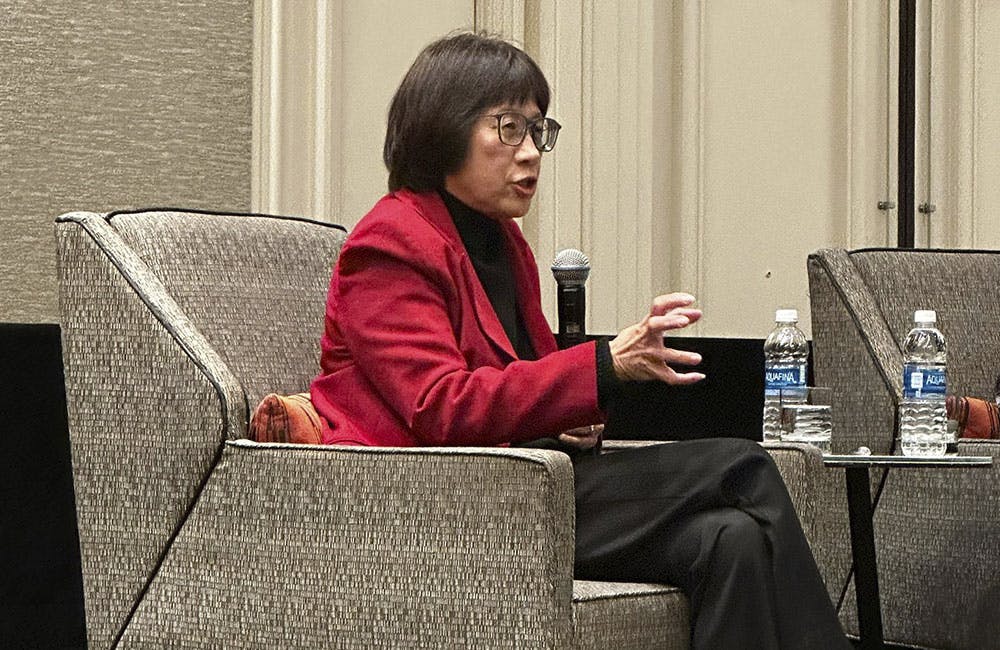DOD’s Heidi Shyu Points to Joint Capabilities for AI Agility
The department is targeting rapid prototyping and joint exercises as it fields critical technology for warfighter readiness.

Interoperability among military service branches is key to strengthening readiness of joint capabilities the Defense Department is hungry to fund like artificial intelligence, Defense Department Under Secretary for Research and Engineering Heidi Shyu said at the AFCEA TechNet Emergence conference in Reston, Virginia, Monday.
“We’re focusing on contested logistics, and on multi-domain command and control,” she said. “Based on the specific scenarios, we started looking for AI prototypes that will accelerate and pull through.”
Funding issues stand in the way of moving forward with timely research and testing, Shyu noted. A two-year budget cycle currently restricts the department’s ability to rapidly prototype and purchase promising new technologies from industry. Shyu also cited the Congressional budget process and the cycle of continuing resolutions as roadblocks to DOD accelerating capabilities and developments.
“The adversary doesn’t have the same constraints,” she said.
Over the past two years, DOD funded $10 million and $20 million for 25 companies as part of its Accelerate the Procurement Fielding of Innovative Technologies program. The investments spanned a broad range of capabilities, including unmanned service vehicles that have a modular payload, giving them the flexibility of carrying munitions, missiles and other cargo.
Other investments include research for unmanned aerial vehicles to take off and land vertically on ships and night-vision goggles that are lighter weight, have higher resolution and provide double the field of view.
“That’s what we’ve been focusing on: rapid prototyping, experimentation, exercises — and pull it quickly into production for the joint fight,” she said. “The other thing that’s important to notice is that we also fund the comparative testing program. We have 98 projects ongoing with 26 countries. And this is where I’m leveraging their technology that they have matured.”
If it works, she will buy it, she said. “Why should we reinvent? If it could accelerate capability by definition is going to be interoperable,” Shyu explained.
It’s important that the new technologies can be deployed across all theaters, she said. These include Indo-Pacific Command, Communications-Electronics Command and Strategic Air Command.
“The technologies that we develop, for example, contract unmanned aircraft systems, direct energy [and] lasers, are going to apply no matter where you are,” she said. “There’s a broad spectrum that we’re developing that’s applicable, independent of the theater we’ll be putting it on.”
She also said that she is working to facilitate and foster a better working relationship between government, industry and academia to enhance intelligence, surveillance and reconnaissance. She met with Indopacom Chief Adm. Sam Paparo, who called for cutting edge AI systems like unmanned warships.
She emphasized the importance of holistically evaluating portfolios and integrating science and technology investments to drive future success.
“We’re tying the pieces together,” she said. “Now we’re tying the [security and privacy] piece to a huge area we’re investing in that could change the future. So all that is starting to integrate together.”
Shyu stressed to the audience of private industry professionals that the DOD is their partner. Entry points to working with the department include the Small Business Innovation Research / Small Business Technology Transfer or the rapid prototyping capabilities of the Rapid Defense Experimentation Reserve, she said.
“We are a sticky customer. Namely, once we know you can produce a good product, we have you for a long, long time,” she said. “The first piece is trying to figure out how to get to us.”
This is a carousel with manually rotating slides. Use Next and Previous buttons to navigate or jump to a slide with the slide dots
-

DOD Has a New Cyber Resiliency Assessment Program
Defense officials tout the continuous assessment feature and scalability of the new program amid increased cyber threats.
5m read -

Cyber Resilience and Recovery Amid Evolving Cyber Threats
Data durability is a key aspect of NIST’s cybersecurity framework for public and private organizations.
21m listen -

How TMF is Helping Agencies Accelerate Tech Modernization
The program launched a new AI pilot to expedite TMF applications as agency leaders urge more to consider applying for funds.
4m read -

Energy Researchers Aim For Holistic Approach to AI Issues
A new center at the Oak Ridge National Laboratory is looking at under-researched areas of AI to better understand how to secure it.
2m read








